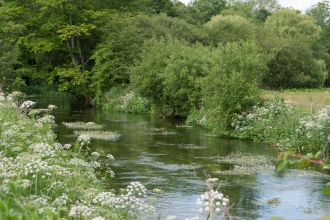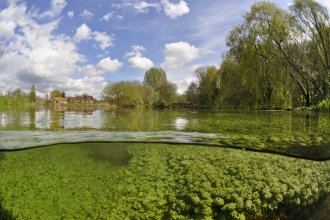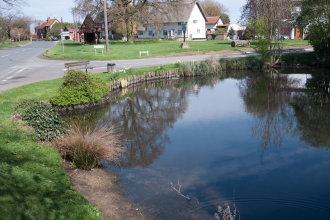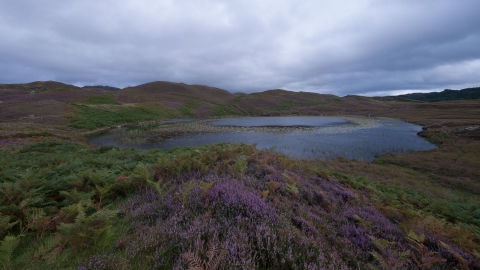
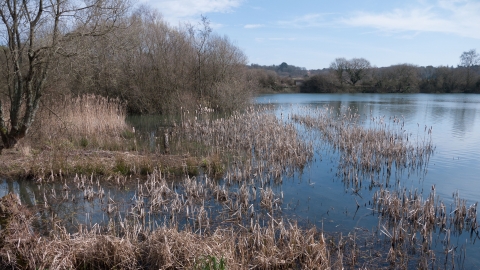
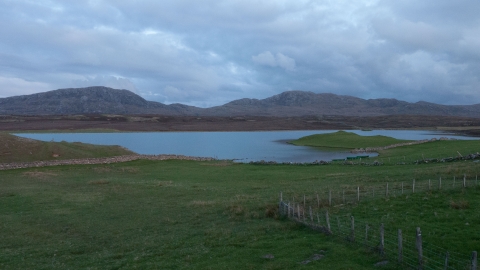
Lakes
Beth yw o?
Broadly, a lake is a very slow moving body of water surrounded by land. There are many open standing water types, ranging from the impressively large and deep nutrient-poor and acidic lakes of the uplands to the shallow, often artificial, nutrient-rich lakes found in the lowlands.
The clear waters and rocky bottoms of upland lakes (called lochs in Scotland and loughs in Ireland) support a characteristic group of shoreline plants that have distinctive rosettes of narrow leaves (known as isoetids). In contrast, pools found in blanket bog contain peat-stained waters that are deep brown and highly acidic – conditions suitable only for a few bog species such as cottongrasses, bogbean and bladderworts.
In the lowlands, the highly fertile lake waters are usually clouded with abundant planktonic algae, which form the basis of a food-web of invertebrates, fish (such as roach, rudd, carp and tench) and fish-eating birds like the great-crested grebe. The best sites are home to a rich variety of aquatic plants and can support ducks such as shoveler and gadwall. Unfortunately, nutrient levels are artificially high in many lowland lakes, and the agricultural fertiliser run-off from surrounding farmland or sewage effluent causes algae to bloom, forming a dense layer that limits other plant and animal life in the lake.
There are, of course, other lake types that do not fit neatly into the spectrum between these main two:
- Marl lakes are found in limestone areas and are superbly clear, with a rich diversity of plant life including stoneworts (a kind of whorled freshwater seaweed encrusted with lime and crunchy to the touch).
- Clear lakes in the upland fringes where acidic and lime-rich bedrocks meet can also be particularly rich in plants. There are a handful of nutrient-poor lowland lakes found in areas with infertile sands that are similar in character to upland lakes.
- Some lakes close to the sea are brackish.
- Turloughs and fluctuating meres are some of the most intriguing and uncommon types of water bodies. Found in shallow basins with no outlet or inlet, they tend to gradually sink in the summer (or sometimes winter), leaving concentric rings of vegetation, and sometimes dry out completely.
Pam fod o fel hyn?
The varying nature of lakes and pools is a consequence of the underlying geology and human activity, both of which also influence nutrient levels. Upland lakes and tarns (small mountain lakes) and lochans (small inland lochs) were generally formed after glaciers scoured out basins in the hard, rocky upland landscape, or deposited barriers of material at the head of valleys that retained water. The waters are generally clear because the low nutrient availability limits the growth of microscopic algae.
In contrast, nutrient-rich lakes are mostly artificial, having been created through gravel extraction or as ornamental lakes. The Norfolk and Suffolk Broads are an unusual example of this, having been created by medieval peat-digging. There are however some natural nutrient-rich lakes, including Upper Loch Erne in Fermanagh, the result of glacial action in a limestone landscape, and lochs associated with machair grassland in the Western Isles.
Turloughs and fluctuating meres are shallow lakes and are something of a special case. Turloughs, are found in limestone country where the permeable rock allows water to well up, flooding the low-lying rock, and then to drain away again. The origins of fluctuating meres are more of an enigma, but they show a time-lag in their response to changes in the water table, so that they can empty in winter and re-fill in summer but may also stay empty or full for several seasons. Because turloughs and fluctuating meres have no inlets, they do not silt up as other shallow lakes do, and some may be very ancient.
Dosbarthiad yn y DU
Lakes are widespread in the uplands, but more scattered in the lowlands. There are three turloughs in Northern Ireland and 12 fluctuating meres, smaller fluctuating pools, in Breckland (this habitat is confined to Britain and Ireland).
Beth i edrych am
Watch for traces of water voles and otters, and if you’re lucky, a glimpse of one. On the shores of upland lakes look for a suite of curious-looking plants including shoreweed, water lobelia and awlwort. In the summer goosander may be present, with black-throated and red-throated divers and goldeneye on some Scottish lochs. Visit nutrient-rich lakes in winter for wildfowl including teal and diving ducks such as tufted and pochard. In summer, spot dragonflies and the specialist aquatic plants, although these can be hard to see.
Cadwraeth
The number of nutrient-poor lakes has remained stable, although some have been degraded by agricultural run-off. Nutrient-rich lakes have suffered more from pollution - successful restoration work at some has focussed on stripping phosphates from sewage and removing nutrient-enriched sediment. The management of waterbodies needs to include their surroundings, as these often form part of the catchment and also play an integral part in the life-cycle of many aquatic species that spend part of their time or some life stages on dry land (e.g. amphibians and some invertebrates).

